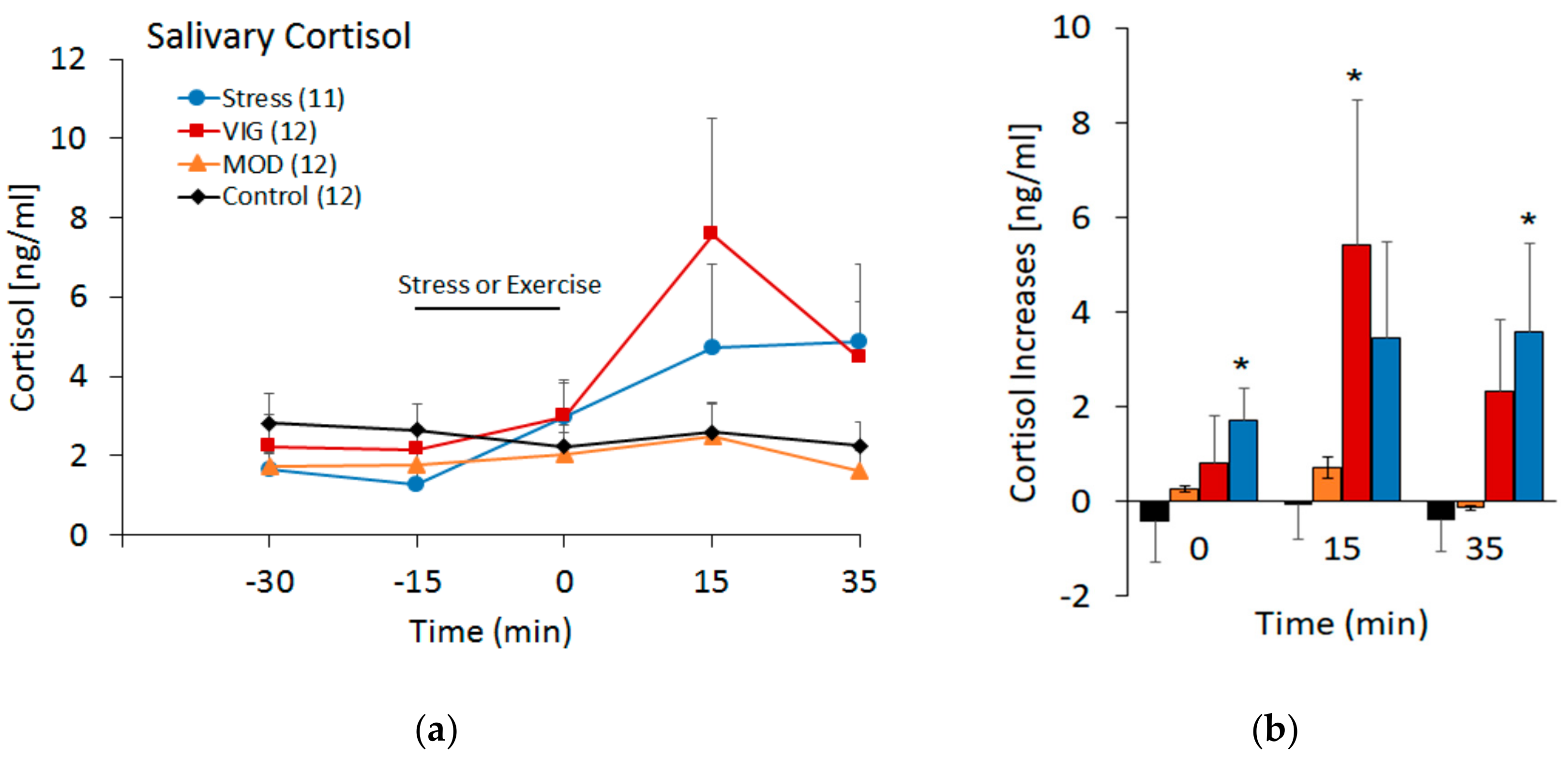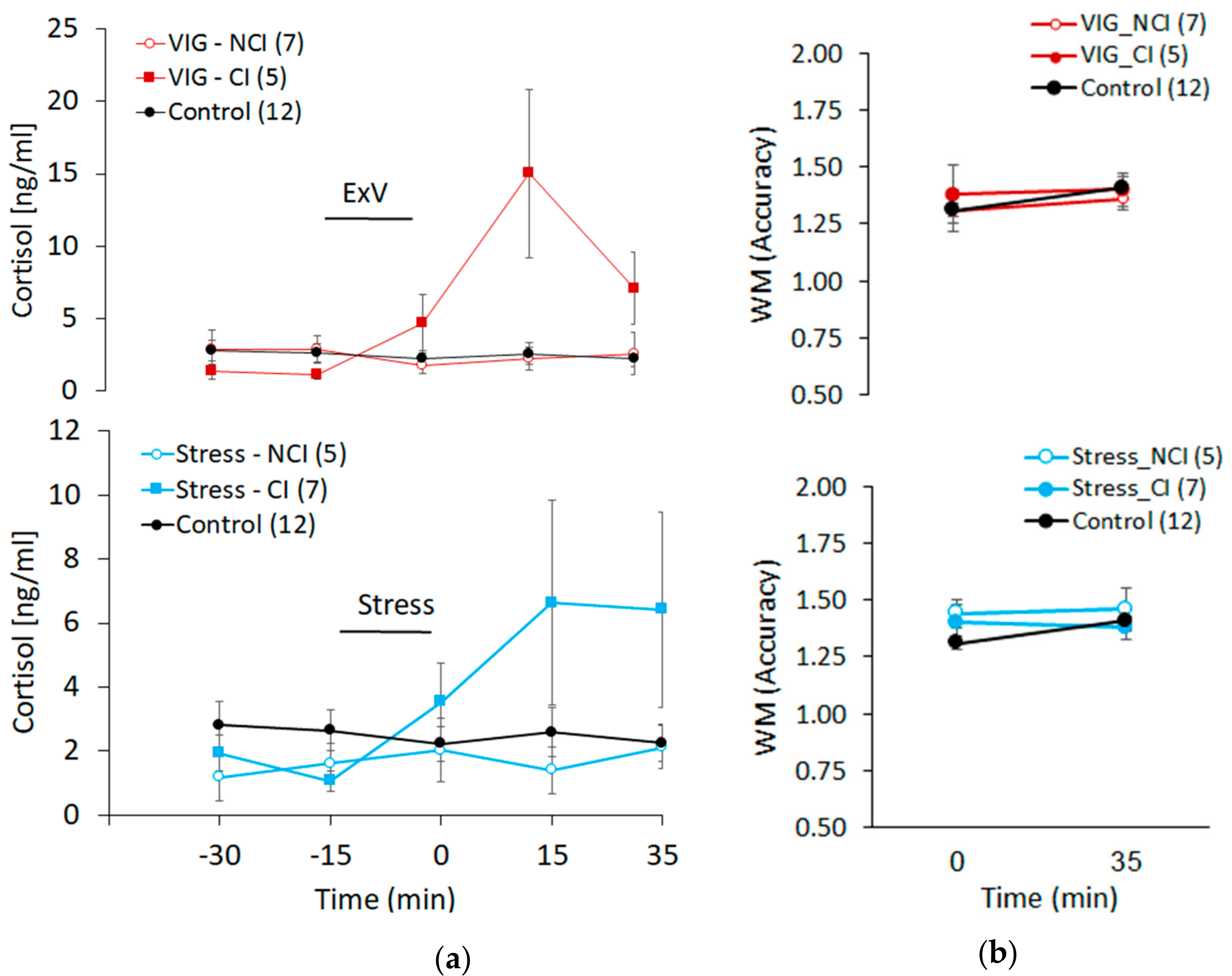Physical Activity versus Psychological Stress: Effects on Salivary Cortisol and Working Memory Performance
Abstract
:1. Introduction
2. Methods and Protocols
2.1. Study Design and Participants
2.2. Experimental Conditions
2.3. Survey
2.4. Working Memory
2.5. Cortisol
2.6. Data and Statistical Analysis
3. Results
3.1. Participants
3.2. Physiological and Behavioral Measures
3.3. Salivary Cortisol
4. Discussion
5. Conclusions
Author Contributions
Funding
Conflicts of Interest
References
- Loprinzi, P.D.; Frith, E. Protective and therapeutic effects of exercise on stress-induced memory impairment. J. Physiol. Sci. 2019, 69, 1–2. [Google Scholar] [CrossRef]
- Weng, T.B.; Pierce, G.L.; Darling, W.G.; Voss, M.W. Differential effects of acute exercise on distinct aspects of executive function. Med. Sci. Sports Exerc. 2015, 47, 1460–1469. [Google Scholar] [CrossRef]
- Schoofs, D.; Preuss, D.; Wolf, O.T. Psychosocial stress induces working memory impairments in an n-back paradigm. Psychoneuroendocrinology 2008, 33, 643–653. [Google Scholar] [CrossRef] [PubMed]
- Ozkaya, G.Y.; Aydin, H.; Toraman, F.N.; Kizilay, F.; Ozdemir, O.; Cetinkaya, V. Effect of strength and endurance training on cognition in older people. J. Sports Sci. Med. 2005, 4, 300–313. [Google Scholar]
- Fu, S.; Caggiano, D.M.; Greenwood, P.M.; Parasuraman, R. Event-related potentials reveal dissociable mechanisms for orienting and focusing visuospatial attention. Brain Res. Cogn. Brain Res. 2005, 23, 341–353. [Google Scholar] [CrossRef]
- Cheung, C.H.M.; McLoughlin, G.; Brandeis, D.; Banaschewski, T.; Asherson, P.; Kuntsi, J. Neurophysiological correlates of attentional fluctuation in attention-deficit/hyperactivity disorder. Brain Topogr. 2017, 30, 320–332. [Google Scholar] [CrossRef]
- Li, L.; Men, W.W.; Chang, Y.K.; Fan, M.X.; Ji, L.; Wei, G.X. Acute aerobic exercise increases cortical activity during working memory: A functional MRI study in female college students. PLoS ONE 2014, 9, e99222. [Google Scholar] [CrossRef] [PubMed]
- McMorris, T. Developing the catecholamines hypothesis for the acute exercise-cognition interaction in humans: Lessons from animal studies. Physiol. Behav. 2016, 165, 291–299. [Google Scholar] [CrossRef] [PubMed]
- McMorris, T.; Turner, A.; Hale, B.J.; Sproule, J. Beyond the catecholamines hypothesis for an acute exercise-cognition interaction: A neurochemical perspective. In Exercise-Cognition Interaction: Neuroscience Perspectives; McMorris, T., Ed.; Academic Press: Cambridge, MA, USA, 2016; pp. 65–103. [Google Scholar]
- McMorris, T.; Sproule, J.; Turner, A.; Hale, B.J. Acute, intermediate intensity exercise, and speed and accuracy in working memory tasks: A meta-analytical comparison of effects. Physiol. Behav. 2011, 102, 421–428. [Google Scholar] [CrossRef] [PubMed]
- Barsegyan, A.; Mackenzie, S.M.; Kurose, B.D.; McGaugh, J.L.; Roozendaal, B. Glucocorticoids in the prefrontal cortex enhance memory consolidation and impair working memory by a common neural mechanism. Proc. Natl. Acad. Sci. USA 2010, 107, 16655–16660. [Google Scholar] [CrossRef]
- Shields, G.S.; Sazma, M.A.; Yonelinas, A.P. The effects of acute stress on core executive functions: A meta-analysis and comparison with cortisol. Neurosci. Biobehav. Rev. 2016, 68, 651–668. [Google Scholar] [CrossRef]
- Budde, H.; Machado, S.; Ribeiro, P.; Wegner, M. The cortisol response to exercise in young adults. Front. Behav. Neurosci. 2015, 9, 13. [Google Scholar] [CrossRef]
- Chen, C.; Nakagawa, S.; An, Y.; Ito, K.; Kitaichi, Y.; Kusumi, I. The exercise-glucocorticoid paradox: How exercise is beneficial to cognition, mood, and the brain while increasing glucocorticoid levels. Front. Neuroendocrinol. 2017, 44, 83–102. [Google Scholar] [CrossRef]
- Hill, E.E.; Zack, E.; Battaglini, C.; Viru, M.; Viru, A.; Hackney, A.C. Exercise and circulating cortisol levels: The intensity threshold effect. J. Endocrinol. Investig. 2008, 31, 587–591. [Google Scholar] [CrossRef] [PubMed]
- Gagnon, S.A.; Wagner, A.D. Acute stress and episodic memory retrieval: Neurobiological mechanisms and behavioral consequences. Ann. N. Y. Acad. Sci. 2016, 1369, 55–75. [Google Scholar] [CrossRef] [PubMed]
- Admon, R.; Treadway, M.T.; Valeri, L.; Mehta, M.; Douglas, S.; Pizzagalli, D.A. Distinct trajectories of cortisol response to prolonged acute stress are linked to affective responses and hippocampal gray matter volume in healthy females. J. Neurosci. 2017, 37, 7994–8002. [Google Scholar] [CrossRef] [PubMed]
- Campisi, J.; Bravo, Y.; Cole, J.; Gobeil, K. Acute psychosocial stress differentially influences salivary endocrine and immune measures in undergraduate students. Physiol. Behav. 2012, 107, 317–321. [Google Scholar] [CrossRef] [PubMed]
- Komiyama, T.; Sudo, M.; Okuda, N.; Yasuno, T.; Kiyonaga, A.; Tanaka, H.; Higaki, Y.; Ando, S. Cognitive function at rest and during exercise following breakfast omission. Physiol. Behav. 2016, 157, 178–184. [Google Scholar] [CrossRef]
- Konishi, K.; Kumashiro, M.; Izumi, H.; Higuchi, Y. Effects of the menstrual cycle on working memory: Comparison of postmenstrual and premenstrual phases. Ind. Health 2008, 46, 253–260. [Google Scholar] [CrossRef]
- Sundstrom Poromaa, I.; Gingnell, M. Menstrual cycle influence on cognitive function and emotion processing-from a reproductive perspective. Front. Neurosci. 2014, 8, 380. [Google Scholar] [CrossRef]
- Genazzani, A.R.; Lemarchand-Beraud, T.; Aubert, M.L.; Felber, J.P. Pattern of plasma ACTH, hGH, and cortisol during menstrual cycle. J. Clin. Endocrinol. Metab. 1975, 41, 431–437. [Google Scholar] [CrossRef] [PubMed]
- Stroud, L.R.; Salovey, P.; Epel, E.S. Sex differences in stress responses: Social rejection versus achievement stress. Biol. Psychiatry 2002, 52, 318–327. [Google Scholar] [CrossRef]
- Elzinga, B.M.; Roelofs, K. Cortisol-induced impairments of working memory require acute sympathetic activation. Behav. Neurosci. 2005, 119, 98–103. [Google Scholar] [CrossRef] [PubMed]
- McNerney, M.W.; Radvansky, G.A. Mind racing: The influence of exercise on long-term memory consolidation. Memory 2015, 23, 1140–1151. [Google Scholar] [CrossRef]
- Frith, E.; Sng, E.; Loprinzi, P.D. Randomized controlled trial evaluating the temporal effects of high-intensity exercise on learning, short-term and long-term memory, and prospective memory. Eur. J. Neurosci. 2017, 46, 2557–2564. [Google Scholar] [CrossRef]
- Birkett, M.A. The Trier Social Stress Test protocol for inducing psychological stress. J. Vis. Exp. 2011, 19, e3238. [Google Scholar] [CrossRef] [PubMed]
- Watson, D.; Clark, L.A.; Tellegen, A. Development and validation of brief measures of positive and negative affect: The PANAS scales. J. Pers. Soc. Psychol. 1988, 54, 1063–1070. [Google Scholar] [CrossRef] [PubMed]
- Dickerson, S.S.; Kemeny, M.E. Acute stressors and cortisol responses: A theoretical integration and synthesis of laboratory research. Psychol. Bull. 2004, 130, 355–391. [Google Scholar] [CrossRef]
- Human, R.; Henry, M.; Jacobs, W.J.; Thomas, K.G.F. Elevated cortisol leaves working memory unaffected in both men and women. Front. Hum. Neurosci. 2018, 12, 299. [Google Scholar] [CrossRef] [PubMed]
- Kuhlmann, S.; Piel, M.; Wolf, O.T. Impaired memory retrieval after psychosocial stress in healthy young men. J. Neurosci. 2005, 25, 2977–2982. [Google Scholar] [CrossRef]
- Oei, N.Y.; Tollenaar, M.S.; Spinhoven, P.; Elzinga, B.M. Hydrocortisone reduces emotional distracter interference in working memory. Psychoneuroendocrinology 2009, 34, 1284–1293. [Google Scholar] [CrossRef]
- Weerda, R.; Muehlhan, M.; Wolf, O.T.; Thiel, C.M. Effects of acute psychosocial stress on working memory related brain activity in men. Hum. Brain Mapp. 2010, 31, 1418–1429. [Google Scholar] [CrossRef] [PubMed]
- Cornelisse, S.; van Stegeren, A.H.; Joels, M. Implications of psychosocial stress on memory formation in a typical male versus female student sample. Psychoneuroendocrinology 2011, 36, 569–578. [Google Scholar] [CrossRef] [PubMed]
- Zandara, M.; Garcia-Lluch, M.; Pulopulos, M.M.; Hidalgo, V.; Villada, C.; Salvador, A. Acute stress and working memory: The role of sex and cognitive stress appraisal. Physiol. Behav. 2016, 164 Pt A, 336–344. [Google Scholar] [CrossRef]
- Wirth, M.M. Hormones, stress, and cognition: The effects of glucocorticoids and oxytocin on memory. Adapt. Hum. Behav. Physiol. 2015, 1, 177–201. [Google Scholar] [CrossRef] [PubMed]
- Blasiman, R.N.; Was, C.A. Why is working memory performance unstable? A review of 21 factors. Eur. J. Psychol. 2018, 14, 188–231. [Google Scholar] [CrossRef] [PubMed]
- Schoofs, D.; Pabst, S.; Brand, M.; Wolf, O.T. Working memory is differentially affected by stress in men and women. Behav. Brain Res. 2013, 241, 144–153. [Google Scholar] [CrossRef]
- Tang, A.; Eng, J.J.; Krassioukov, A.V.; Tsang, T.S.; Liu-Ambrose, T. High- and low-intensity exercise do not improve cognitive function after stroke: A randomized controlled trial. J. Rehabil. Med. 2016, 48, 841–846. [Google Scholar] [CrossRef] [PubMed]
- Venckunas, T.; Snieckus, A.; Trinkunas, E.; Baranauskiene, N.; Solianik, R.; Juodsnukis, A.; Streckis, V.; Kamandulis, S. Interval running training improves cognitive flexibility and aerobic power of young healthy adults. J. Strength Cond. Res. 2016, 30, 2114–2121. [Google Scholar] [CrossRef]
- Bantoft, C.; Summers, M.J.; Tranent, P.J.; Palmer, M.A.; Cooley, P.D.; Pedersen, S.J. Effect of standing or walking at a workstation on cognitive function: A randomized counterbalanced trial. Hum. Factors 2016, 58, 140–149. [Google Scholar] [CrossRef]
- Hogan, C.L.; Mata, J.; Carstensen, L.L. Exercise holds immediate benefits for affect and cognition in younger and older adults. Psychol. Aging 2013, 28, 587–594. [Google Scholar] [CrossRef] [PubMed]
- Tsujii, T.; Komatsu, K.; Sakatani, K. Acute effects of physical exercise on prefrontal cortex activity in older adults: A functional near-infrared spectroscopy study. Adv. Exp. Med. Biol. 2013, 765, 293–298. [Google Scholar] [CrossRef]
- Hwang, J.; Castelli, D.M.; Gonzalez-Lima, F. Cognitive enhancement by transcranial laser stimulation and acute aerobic exercise. Lasers Med. Sci. 2016, 31, 1151–1160. [Google Scholar] [CrossRef] [PubMed]
- Lo Bue-Estes, C.; Willer, B.; Burton, H.; Leddy, J.J.; Wilding, G.E.; Horvath, P.J. Short-term exercise to exhaustion and its effects on cognitive function in young women. Percept. Mot. Skills 2008, 107, 933–945. [Google Scholar] [CrossRef] [PubMed]
- Sibley, B.A.; Beilock, S.L. Exercise and working memory: An individual differences investigation. J. Sport Exerc. Psychol. 2007, 29, 783–791. [Google Scholar] [CrossRef]
- Crush, E.A.; Loprinzi, P.D. Dose-response effects of exercise duration and recovery on cognitive functioning. Percept. Mot. Skills 2017, 124, 1164–1193. [Google Scholar] [CrossRef]
- Nopembri, S.; Sugiyama, Y.; Saryono Rithaudin, A. Improving stress coping and problem-solving skills in children in diaster-prone area through cooperative physical education and sports lesson. J. Hum. Sport Exerc. 2019, 14, 185–194. [Google Scholar] [CrossRef]



| Age, Mean Years | 25.0 (4.2) |
|---|---|
| Gender, % male | 100.0 |
| Race-Ethnicity, % | |
| Non-Hispanic White | 58.3 |
| Non-Hispanic Black | 16.7 |
| Other | 25.0 |
| Education, % | |
| Undergraduate Student | 41.7 |
| Graduate Student | 58.3 |
| Body Mass Index, mean kg/m2 | 25.7 (3.3) |
| Waist Circumference, mean cm | 90.7 (11.2) |
| Physical Activity, mean MVPA/week | 235.0 (100.3) |
| Variable | Control | Moderate Exercise (MOD) | Vigorous Exercise (VIG) | Psychological Stress |
|---|---|---|---|---|
| Heart Rate, mean beats per minute | ||||
| Rest | 71.6 (11.8) | 69.2 (14.6) | 70.8 (13.3) | 73.0 (11.3) |
| Mid-Point | - | 110.8 (16.5) | 161.4 (19.1) | 89.5 (17.5) |
| End | - | 113.7 (16.2) | 181.9 (11.0) | 85.6 (13.6) |
| 5-Min Post | - | 76.2 (15.9) | 105.2 (15.0) | - |
| Affect, Post Stimulus | ||||
| Positive PANAS, mean | 22.5 (8.9) | 25.2 (8.6) | 30.2 (8.0) | 21.6 (5.2) |
| Negative PANAS, mean | 12.7 (3.0) | 12.2 (2.2) | 12.6 (3.0) | 22.3 (9.4) |
| Cognitive, mean RT (2 N-Back) a | ||||
| Early WM (0 min) | 2.90 (0.11) | 2.85 (0.08) | 2.94 (0.15) | 2.88 (0.11) |
| Late WM (35 min) | 2.88 (0.09) | 2.82 (0.08) | 2.90 (0.12) | 2.84 (0.07) |
| Cognitive, mean accuracy (2 N-Back) b | ||||
| Early WM (0 min) | 1.31 (0.11) | 1.39 (0.12) | 1.30 (0.22) | 1.35 (0.27) |
| Late WM (35 min) | 1.40 (0.17) | 1.33 (0.15) | 1.35 (0.12) | 1.34 (0.27) |
© 2019 by the authors. Licensee MDPI, Basel, Switzerland. This article is an open access article distributed under the terms and conditions of the Creative Commons Attribution (CC BY) license (http://creativecommons.org/licenses/by/4.0/).
Share and Cite
Ponce, P.; del Arco, A.; Loprinzi, P. Physical Activity versus Psychological Stress: Effects on Salivary Cortisol and Working Memory Performance. Medicina 2019, 55, 119. https://doi.org/10.3390/medicina55050119
Ponce P, del Arco A, Loprinzi P. Physical Activity versus Psychological Stress: Effects on Salivary Cortisol and Working Memory Performance. Medicina. 2019; 55(5):119. https://doi.org/10.3390/medicina55050119
Chicago/Turabian StylePonce, Pamela, Alberto del Arco, and Paul Loprinzi. 2019. "Physical Activity versus Psychological Stress: Effects on Salivary Cortisol and Working Memory Performance" Medicina 55, no. 5: 119. https://doi.org/10.3390/medicina55050119
APA StylePonce, P., del Arco, A., & Loprinzi, P. (2019). Physical Activity versus Psychological Stress: Effects on Salivary Cortisol and Working Memory Performance. Medicina, 55(5), 119. https://doi.org/10.3390/medicina55050119





